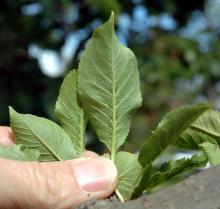See:
Cherry (Prunus spp.) - Eola Rasp Leaf (Yellow Bud Mosaic)
Cause Several causes have been linked with stem pitting symptoms. Tomato ringspot virus is associated with a disease known as Prunus stem pitting and is vectored by the dagger nematode. Tomato bushy stunt virus has been associated with the disease in other parts of North America. An unknown graft-transmitted agent has been observed in California and is suspected to be in the Pacific Northwest. The cultivars Bing and Mazzard show severe symptoms, while Mahaleb shows less conspicuous wood marking. The cultivar Colt reacts to tomato ringspot virus with a hypersensitive reaction, thus preventing movement of the virus away from the site of nematode transmission into the scion.
Symptoms Premature defoliation from the lower portion of the tree is an initial symptom. Severe pitting (longitudinal depressions) can be found in the woody cylinder of the scion and/or rootstock. Thick, spongy bark, ridges and furrows in the trunk, cambial necrosis, and necrotic streaking in the wood have also been associated with stem pitting. The cultivar Bing exhibits sparse canopies, unmarketable fruit, limb dieback, and eventually tree death. The virus is latent in the cultivar Royal Ann such that pitting is only observed in the rootstock.
Cultural control
- Plant certified nursery stock.
- Remove diseased trees.
- Use colt rootstock.
References Uyemoto, J.K., Luhn, C.F., Griesback, J.A., and Grant, J.A. 1995. Occurrence and control of cherry stem pitting disease. Plant Disease. 79:366-368.
Zhang, Y.P., Uyemoto, J.K., and Kirkpatrick, B.C. 1998. Analysis of double-stranded RNAs from cherry trees with stem pitting in California. Plant Disease 82:871-874.


